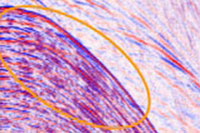简介:3-D GSMP是一种新型多分支数据处理技术。它是以种表面相关削减(SRME)三维工具,能够精确描述多分支油藏,包括曲折分散的油藏。该项技术克服了以往现场数据分散缺失不规则等缺点,提供包括宽方位角,各种复杂程度和各种水深情况下的地球物理描述。

The past few years have seen a tremendous increase in the acquisition of wide-azimuth (WAZ) and full-azimuth (FAZ) surveys that provide enhanced illumination in areas of complex geology such as subsalt and reef structures. These techniques have provided a step change improvement in image quality compared to conventional narrow-azimuth surveys, even when using minimal processing and existing, conventional-survey velocity models.
The improvement in image quality is taken to the next level when the WAZ and FAZ data are processed using the latest true-azimuth 3-D demultiple techniques, then combined with well data and non-seismic measurements to build ever more highly constrained velocity models, and finally migrated using two-way wave-equation methods such as reverse time migration (RTM). True azimuth 3-D multiple attenuation using general surface multiple prediction (GSMP) has been observed to provide one of the key advances in accurate imaging of complex structures.
A closer look at 3-D GSMP
Three-D GSMP is a full 3-D implementation of surface-related multiple elimination (SRME) that accurately predicts complex multiples, including diffracted and scattered multiple energy. The technology overcomes the challenges of sparse, missing or irregular field data, providing effective results in all geophysical situations, including WAZ or conventional towed-streamer surveys; any degree of structural complexity; any degree of cable feathering; and all water depths.
With 3-D GSMP, seismic data can be used to predict multiples in a true 3-D fashion. Since GSMP is a data-driven technology, it works with the recorded wavefield at the surface. Therefore, neither assumptions about the nature of the subsurface nor corrections for the irregularities in acquisition are required. The algorithm can predict the multiples and eliminate them just using the recorded data.
In areas with complex imaging challenges, 3-D GSMP ensures the preservation of complex primary events such as double bounces, which may be removed with techniques such as conventional or shifted-apex Radon demultiple. This means that high-end imaging algorithms like RTM can correctly migrate these events for an accurate reservoir image. Unlike other implementations of 3-D SRME, there is no requirement to regularize, extrapolate to zero offset, or interpolate the shot and receiver sampling intervals prior to 3-D GSMP.
Additionally, minimal pre-processing is required since interpolation, regularization, and extrapolation is carried out on-the-fly. Critical to the quality of the multiple model, 3-D GSMP predicts the multiples at true azimuth, ensuring that the multiple model accurately matches the multiples in the input data.
In general, 3-D methods represent a step change in terms of the additional compute and data manipulation effort required in processing seismic data. In an attempt to minimize the costs associated with this effort, assumptions are often made when implementing 3-D algorithms that can compromise the quality of the final result. The design of the 3-D GSMP algorithm avoids many of these assumptions, allowing higher quality results.
The future
In the past, E&P was common in areas with simple geological structures that were consequently easier to image. Now that acquisition is occurring in more complex surface and geological areas, more defined images of the earth are needed. Using conventional seismic processing methods to recompose the image of the Earth is simply not enough. The addition of information from well logs, vertical seismic profiles, gravity and magnetotelluric surveys, and geomechanical modeling to seismic data will further constrain our data processing methodologies, improving the model accuracy required for subsalt imaging. Therefore, a wide variety of technologies such as 3-D GSMP, wavefield extrapolation multiple modeling, and RTM are needed to improve the quality of geophysical imaging and hydrocarbon production monitoring.
